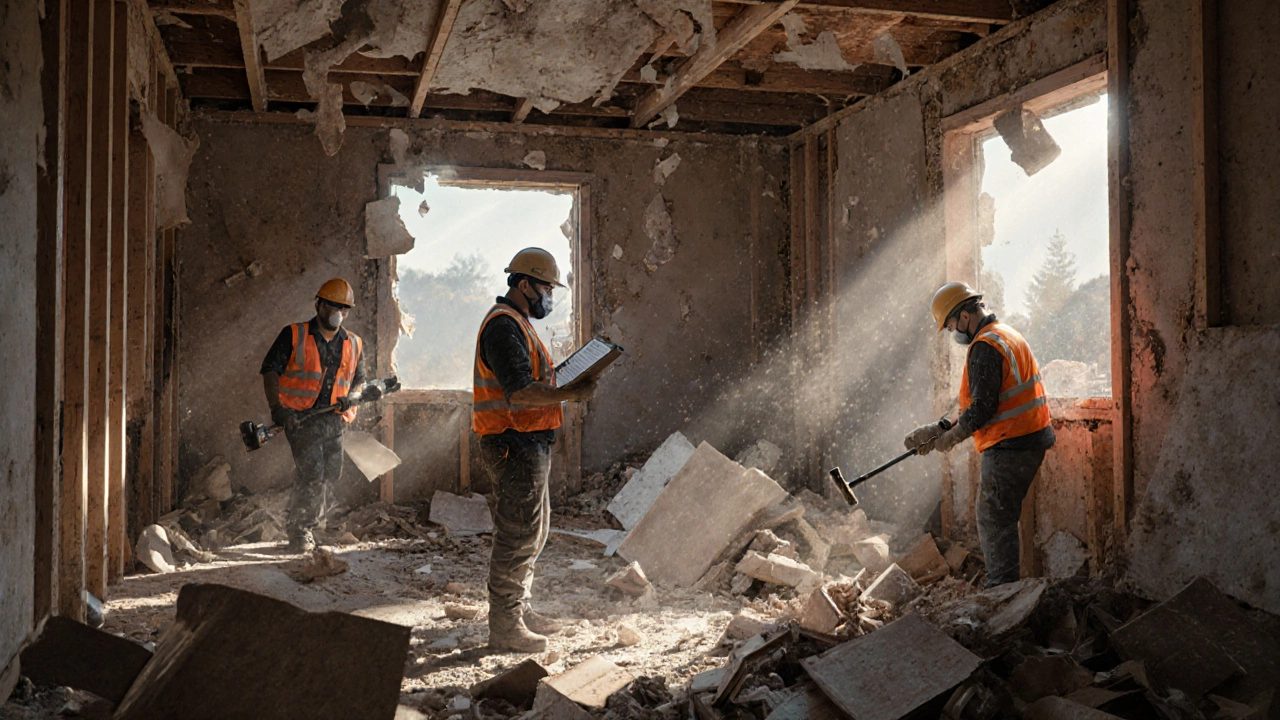Renovation Timeline Calculator
Select the renovation phases you need and adjust time ranges for accuracy
Estimated Renovation Timeline
Total estimated days:
0
Based on selected phases and their midpoints
This is an estimate based on typical renovation phases. Actual time may vary due to weather, unforeseen issues, or scope changes.
When you start planning a remodel, the first question that pops up is: how many days does it take to renovate a house? The answer isn’t a one‑size‑fits‑all number, but a clear timeline broken down into phases helps you set realistic expectations, keep the budget in line, and avoid endless delays.
Understanding the House renovation timeline is the sequence of work stages, each measured in days or weeks, that together transform an existing home into a refreshed living space
A typical renovation goes through several distinct steps: planning, permits, demolition, structural work, utilities, interior finishes, and final inspection. Each step has its own buffer for unexpected issues, weather, or material delivery. Below we walk through every stage, give a realistic day range, and highlight the key players you’ll meet along the way.
1. Planning & Design (5‑14 days)
Before a hammer swings, you need a solid plan. This is when you decide on the scope-whether it’s a full‑gut remodel or a focused kitchen upgrade. Grab a designer or an architect if you’re changing room layouts, and start sketching out floor plans.
- Define goals: open‑plan living, more storage, energy efficiency.
- Set a budget ceiling and allocate a 10‑15% contingency.
- Choose materials and finishes early to avoid mid‑project swaps.
Most homeowners finish the planning phase within two weeks if decisions are made promptly.
2. Securing a building permit (7‑21 days)
In Auckland and most of NewZealand, a building consent is mandatory for structural changes, plumbing upgrades, and electrical rewiring. Submit detailed drawings and specifications to the local council; they’ll review for compliance with the Building Code.
- Simple interior upgrades often get fast‑track approval (7‑10 days).
- Major extensions or load‑bearing wall removals can take up to three weeks.
While you wait, you can order long‑lead items like windows or custom cabinetry.

3. Demolition & Site Preparation (3‑10 days)
Once permits are in hand, the demolition crew clears out the old. This includes stripping finishes, removing cabinets, and sometimes taking down walls.
- Partial demolition (e.g., kitchen) typically finishes in 3‑5 days.
- Full‑gut removal of multiple rooms can stretch to 8‑10 days, especially if hazardous materials (asbestos) are present.
Safety checks and debris disposal are done concurrently, keeping the site tidy for the next crew.
4. Structural Work: framing and Core Repairs (7‑21 days)
With a clean shell, the contractor steps in to rebuild walls, install new joists, or reinforce foundations. The duration hinges on the project's complexity.
- Simple wall reshaping: 7‑10 days.
- Adding a room or raising a roof: up to three weeks.
Inspections often happen midway to verify structural integrity before moving on.
5. Rough‑In Trades: plumbing and electrical (5‑14 days)
Now the tradespeople run new pipes, drains, wiring, and circuit boxes. Coordination is critical-plumbers need access to walls before drywall goes up, and electricians must finish before final finishes.
- Full house reroute of water lines and circuits: 10‑14 days.
- Targeted kitchen or bathroom upgrades: 5‑7 days.
Both trades require separate inspections; plan a day or two buffer for any corrections.
6. Interior Finishes: drywall, flooring, and painting (10‑21 days)
This is where the house starts looking like a home again.
- Drywall: taping, mudding, sanding - 5‑8 days.
- Flooring: hardwood, tile, or carpet - 5‑10 days depending on material.
- Painting: priming and two coats - 4‑7 days.
Scheduling overlaps (e.g., flooring before final paint) can shave a few days off the overall timeline.
7. Final Touches & inspection (3‑7 days)
Once all trades sign off, a final walkthrough with the building consent officer confirms everything meets code. You’ll also do a personal quality check: verify light switches, test taps, and ensure doors close properly.
- Minor punch‑list items (trim adjustments, caulking) are usually fixed within a couple of days.
- Final certification is granted within 3‑5 days after any required re‑work.
After approval, you can move back in or schedule furniture delivery.

Quick Reference: Typical Renovation Types & Days Needed
| Renovation Type | Typical Days | Key Bottleneck |
|---|---|---|
| Full‑gut interior remodel | 45‑70 | Permit approval & inspections |
| Kitchen upgrade (mid‑range) | 25‑35 | Appliance lead time |
| Bathroom remodel | 20‑30 | Plumbing coordination |
| Adding a single bedroom | 30‑45 | Structural framing |
| Exterior cladding refresh | 15‑25 | Weather delays |
Tips to Keep Your Timeline on Track
- Hire a licensed project manager or a reputable general contractor who can juggle trades and paperwork.
- Order long‑lead items (custom cabinets, specialty tiles) at least 4‑6 weeks before they’re needed.
- Maintain a daily log of completed tasks; small delays become visible early.
- Allow a 10‑15% contingency not just in budget but also in schedule.
- Keep communication channels open-weekly check‑ins with the contractor prevent misunderstandings.
What Can Extend the Timeline?
Even with a solid plan, a few common factors can push the finish date further out:
- Unexpected structural issues discovered during demolition (rot, pest damage).
- Weather that halts exterior work or delays material deliveries.
- Regulatory hiccups such as additional consent requirements.
- Supplier shortages, especially for imported timber or high‑demand tiles.
- Scope creep-adding new rooms or upgrades mid‑project.
Identifying these risks early and planning buffers can save you headaches later.
Next Steps After Your Renovation Ends
When the final inspection clears, consider these actions:
- Update your home insurance policy to reflect new value.
- Collect warranties for appliances, flooring, and fixtures.
- Schedule a professional energy audit to prove any efficiency improvements.
- Share before‑and‑after photos-great for personal satisfaction and future resale.
- Leave a detailed handover note for any future homeowners or renters.
Frequently Asked Questions
How long does a full‑gut remodel typically take?
A full‑gut interior remodel usually spans 45‑70 days, including planning, permits, demolition, structural work, trades, finishes, and final inspection. The biggest time‑eaters are permit processing and any unexpected structural repairs discovered mid‑project.
Can I speed up the permit process?
Submitting a complete set of drawings, specifying compliant materials, and responding quickly to council queries can shave a week or more off the typical 7‑21‑day window. Some councils also offer an accelerated fast‑track service for a modest fee.
What’s the most common cause of schedule overruns?
Unexpected structural damage uncovered during demolition is the top culprit. When rotten joists, hidden water damage, or asbestos are found, repairs must be added to the scope, extending both budget and timeline.
Do I need a separate contractor for each trade?
It’s often smoother to hire a licensed general contractor who manages sub‑trades (plumbers, electricians, drywall crew). They coordinate schedules, handle permits, and ensure each trade follows the overall plan, reducing communication gaps.
How can I protect my budget while staying on schedule?
Set a firm budget cap, allocate a 10‑15% contingency, and lock in prices for major items (cabinets, appliances) early. Also, stick to the approved scope-any additions should be documented and re‑budgeted before work begins.


Write a comment